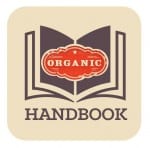New NRCS handbook to support conservation on organic farms
From NRCS: By Ben Bowell and Lindsay Haines

A new Handbook supports NRCS conservation planners and other agricultural professionals as they work with organic producers.
Consumer demand for organic products continues to grow. The Organic Trade Association, which represents more than 8,500 organic businesses across 50 states, reports that demand for organic products exceeded $39 billion in 2014. To meet that demand, more farmers and ranchers are pursuing organic certification and seeking assistance through USDA programs.
The Natural Resources Conservation Service’s (NRCS) is making sure that its people in the field are prepared to work with organic producers and those who want to get into organics. The agency has just released to its staffs the new Organic Farming Handbook, which describes the things they need to consider when working with organic producers.
“I’m sure the NRCS staff in my county would have appreciated this information when I first started working with them,” says Jeff Eschmeyer, organic farmer and NRCS special assistant to the chief. “Organic producers use different practices and must follow USDA organic rules. Our new handbook provides this critical information to our conservation planners and other ag professionals who design practices for these farmers and ranchers.”
The Organic Farming Handbook describes organic systems and identifies key resources to guide conservation planning and implementation on organic farms. Producers and other audiences may also find the handbook useful.

The Handbook describes a range of conservation practices and key resources for use on organic operations – some the same in conventional operations, some different — such as nutrient management, crop rotations, livestock grazing and pest management.
The handbook describes conservation practices and key resources for use on organic operations – some the same as those used in conventional operations, such as nutrient management, crop rotations, livestock grazing and pest management. The handbook includes additional practices and resources that address producers’ needs that are identified in the recent Organic Census.
Though this information is specifically for conservation on organic operations, producers of all kinds can benefit from many of the practices in the handbook.
A team of NRCS staff and partner organizations from across the country developed the handbook. NRCS representatives ranged from those who work directly with producers in California and Indiana to its specialists in agronomy, soil health, wildlife biology, water quality, and other specialty areas.
Partner organizations that brought their expertise to the handbook include: Black Family Land Trust, Carolina Farm Stewardship Association, Center for Rural Affairs, Florida Organic Growers, Midwest Organic & Sustainable Education Service, National Center for Appropriate Technology, National Sustainable Agriculture Coalition, Northwest Center for Alternative to Pesticides, Oregon Tilth, Virginia Biological Farming Association and Wild Farm Alliance.
For more information on NRCS assistance for organic producers and the NRCS Organic Farming Handbook, visit www.nrcs.usda.gov/organic.









